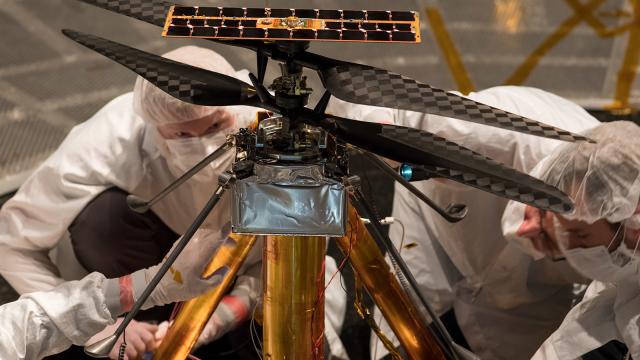Six-wheeled rovers on Mars are great, but imagine a helicopter flying through the thin Martian air. Darting from location to location, the craft would give us a bird’s eye view of the Red Planet. To test the feasibility of this idea, NASA will be sending a rotary-wing aircraft to Mars, and as recently concluded flight tests have shown, this tiny chopper is officially ready for prime time.
In July 2020, a United Launch Alliance Atlas V rocket will launch from Cape Canaveral Air Force Station in Florida en route to Mars. On board will be the Mars 2020 rover, but nestled within its belly will be a tiny, 1.8kg helicopter. Once at Mars and aloft, this aircraft will become the first to fly above the surface of an alien world.
Engineers at the Mars Helicopter project at JPL in Pasadena, California, have reached an important developmental milestone, in which a model of the helicopter was put through a series of critical flight tests, reports NASA.
The little chopper achieved controlled and sustained flight in simulated Martian conditions — a good sign that it’ll perform on the Red Planet as expected.
“Gearing up for that first flight on Mars, we have logged over 75 minutes of flying time with an engineering model, which was a close approximation of our helicopter,” said project manager MiMi Aung in a NASA press release. “But this recent test of the flight model was the real deal. This is our helicopter bound for Mars. We needed to see that it worked as advertised.”
The helicopter and the Mars 2020 rover are expected to land on the Red Planet in February 2021. The aircraft won’t be deployed immediately, with NASA saying the inaugural flight should happen “a few months” into the mission. Once deployed and ready to go, the helicopter will be put through a series of flight tests, none longer than 90 seconds.
The Mars helicopter is fairly barebones, featuring few bells and whistles. NASA is describing it as a “technology demonstrator” — a real-world (or real-alien-world) test of the system.
Results from the test will be used to inform the development of more sophisticated flying aircraft meant for Mars. Like a helicopter with a camera, for instance. Which would be so cool.
Indeed, building a chopper for Mars is a major technological challenge. The device has to be able to withstand the extreme temperature fluctuations on Mars, including at night when the temperature dips to below -90C.
Each of the craft’s 1500 different components, comprised of aluminium, silicon, carbon, foil and foam, will have to endure the contractions and expansions wrought by the dramatically changing environmental conditions.
The capacity for flight is dependent on the presence of a medium, which provides the necessary lift. Earth’s atmosphere is fairly thick, but the same cannot be said for Mars, where the atmosphere is super thin — a mere one per cent of what it is here on Earth. To be fair, such conditions do exist on Earth, but at an altitude of 30,480m.
Not wanting to test their little helicopter at such an extreme height, the NASA engineers recreated these conditions inside the JPL Space Simulator. In preparation for the flight test, all the gases were sucked out from the 7.5m-wide vacuum chamber and replaced with carbon dioxide, making it just like Mars.
Happily, the chopper was still able to get off the ground, which it did for around a minute, attaining a modest altitude of 5cm.
Another issue with Mars is its low gravity, which is approximately 38 per cent of Earth’s gravity. On Mars, the 1.8kg helicopter will be closer to 700g, dramatically altering its flight profile.
Simulating this low gravity was considerably more challenging, but NASA did it by using a “gravity offload system”. In tests, a motorised strap was connected to the top of the helicopter, providing an assist equal to the missing 62 per cent of Earth’s gravity.
“The gravity offload system performed perfectly, just like our helicopter,” said Teddy Tzanetos, the test conductor for the Mars Helicopter at JPL.
“We only required a 2-inch (5-centimeter) hover to obtain all the data sets needed to confirm that our Mars helicopter flies autonomously as designed in a thin Mars-like atmosphere; there was no need to go higher. It was a heck of a first flight.”
So, with 75 minutes of test flights in the books, and with a chopper seemingly ready for the rigours of Mars, this stage of the certification process is complete.
“The next time we fly, we fly on Mars,” declared Aung.
“Watching our helicopter go through its paces in the chamber, I couldn’t help but think about the historic vehicles that have been in there in the past. The chamber hosted missions from the Ranger Moon probes to the Voyagers to Cassini, and every Mars rover ever flown. To see our helicopter in there reminded me we are on our way to making a little chunk of space history as well.”
No doubt, this little helicopter could be the start of something big, providing us with an entirely new way of exploring the surface of another world.
[NASA]
